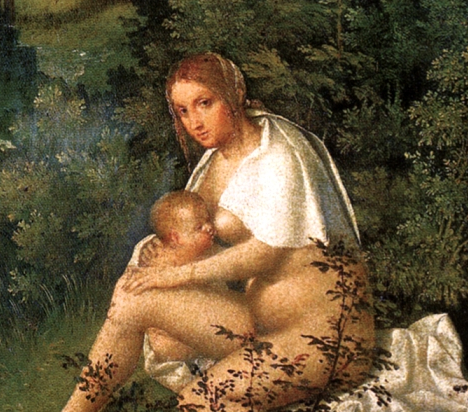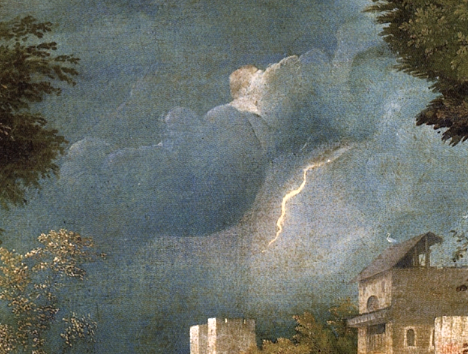|
Giorgione's
mysterious painting, "The Tempest" is the perfect choice for any
introductory art history or
art appreciation course. The painting has for hundreds of years enticed critics to offer interpretations; as there is no definitive
interpretation and Giorgione left no written clues, anyone can play.
If you ask students for their interpretation of the painting, the results range
from amusing to astounding. Many students have a great eye for art, while others
are noticeable less gifted. One less gifted student stands out in my
mind. He was a baseball player, perhaps a baseball major. He wore his cap
pulled down over his eyes and brought his glove to class, just in case the
teacher might toss a ball his way. I nicknamed him, Joe Baseball. After completing a basic
humanities course, he then enrolled in a self-paced course based on Kenneth Clark's
Civilisation series
that included The Tempest among the teaching materials. As I remember our exchange on the
painting was something like this:
Teacher, "What do you think the clouds and lightning symbolise?"
Joe, "It's going to rain?"
Teacher, "How about the broken columns, what might they symbolise?"
Joe, "There use to be a building there?"
We then moved on to the another question. Joe earned a passing grade, as attempting to change literal minds
is tricky - they might go from seeing only the obvious to spotting angels in the
wood work and space aliens in a Leonardo painting. Over the years I
learned to let them be.
Others, students or otherwise, make up for the lack of a good
eye for art with with an active imagination. There are many
published interpretations of the painting. Some critics have taken the man to be a shepherd, a soldier, or a
Venetian noble. The woman has been
taken for a gypsy, a hooker, or the Madonna. Here
are a few well know interpretations, followed by my two cents worth:
1) The painting depicts Adam and Eve with the infant Cain.
The city is Paradise and the figures are shown just after their expulsion. The
lightning bolt is the angry God. (What happened to Abel?)
2) The figures are Joseph, Mary and the baby Jesus resting on their
flight into Egypt. (Perhaps the donkey is offstage grazing.)
3) This is an allegorical depiction of the virtues, Fortitude
and Charity - set against Fortune, the rising storm. (Should not Fortitude
be more heavily armed? Only a stick?)
4. The young mother is Mother Earth, a personification of the nurturing
aspects of nature. (Are not all nursing mothers personifications of nurturing?)
5. Another suggestion is that the young woman is Hypsipyle, the nursemaid in
The Seven Against Thebes. The
soldier is Capaneus, one of The
Seven Against Thebes, who stood at the wall of Thebes and boasted that Zeus
could not stop him from invading the city. Zeus responded with a lightning bolt
to the head of Capaneus. (The bolt in the painting is way off target.)
6. The woman is the Greek goddess Demeter and the man is Iasion. The
two met at a wedding and, in Greek fashion, made love in a thrice-ploughed field.
Zeus spotted mud on Demeter's back side, guessed what happened and struck Iasion
dead with a thunderbolt. The union resulted in the birth of twins, Ploutos and
Philomelus. (Where is the other twin? Was not Iasion long gone before the
birth of the twins?)
7. Interpretation doesn't halt with the figures, they go on to the bird on the
roof and to the column. The bird is either a crane, one of the attributes of
Demeter, or a stork, symbol of fertility. The
broken column just behind the young man signifies a life cut short. (Or, as Joe
pointed out, a
building used to be there.)
8. The poet Byron thought the male was Giorgione himself, and the other
figures his wife and child. (Did the husband spent all their money on his fancy clothes, leaving wife and child naked
and exposed to the elements,
not even an umbrella for the coming storm. Tut, tut.)
What can we reasonable say about the
painting? The man is perhaps dressed as a
member of the Compagnia della Calza (Companions of the Order of the
Stocking), a group of young Venetians in the 15th and 16th centuries who
organized theatrical and musical events (see below). The staff may indicate a shepherd, but
probably not the weapon of a soldier. The man and woman don't seem to be a
family group, the figures are separated by the stream and hardly seem aware of
each other. He glances over his shoulder beyond her; she looks out of the
painting at the viewer and seemingly pays the man no attention at all.
In conclusion, the earliest interpretation available
is appealing. A 1569 inventory of the collection of the Vendramin
family, who owned the painting, records the work as a 'una cingana, un
pastor in un paeseto con un ponte' (a gypsy, a shepherd in a little
landscape with a bridge). Very well, but
how did they identify the woman as a gypsy? Also, we can see one breast, but I am unable to ascertain if it is right or left breast?

 |
 |
| "What about the bird, Joe Baseball?" "In the background behind the broken columns there is a Mosque. What might that suggest to you?"
| I did find this image of a Compagnia della Calza
costume. Certainly no dead ringer for the
shepherd's costume.
|
Coda
Xrays have shown two more figures, but as
Giorgione painted them out, I am unable to see how they effect the
interpretation of the finished painting. How can you reasonably comment on
figures that are not there?
My wife complains that she has never seen the
painting. Although we have visited the Accademia several times, she
is never able to see over the crowd seemingly perpetually gathered in front of
the painting.
Also, I reacted to a New Yorker piece
stating another artist "cribbed" the
Giorgione nude. You might find my reaction
of interest.
 |
Gallerie dell'Accademia, Venice |
.

|





